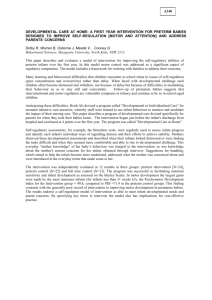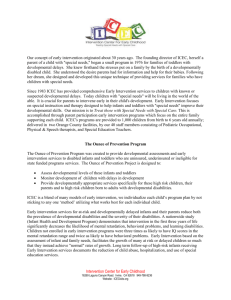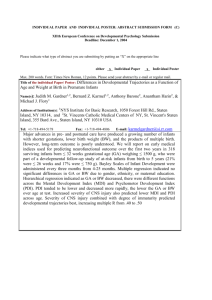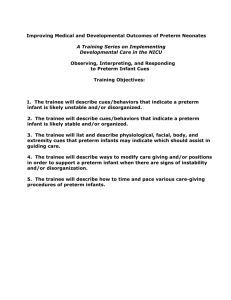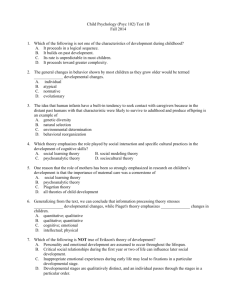Early Experience Alters Brain Function and Structure
advertisement
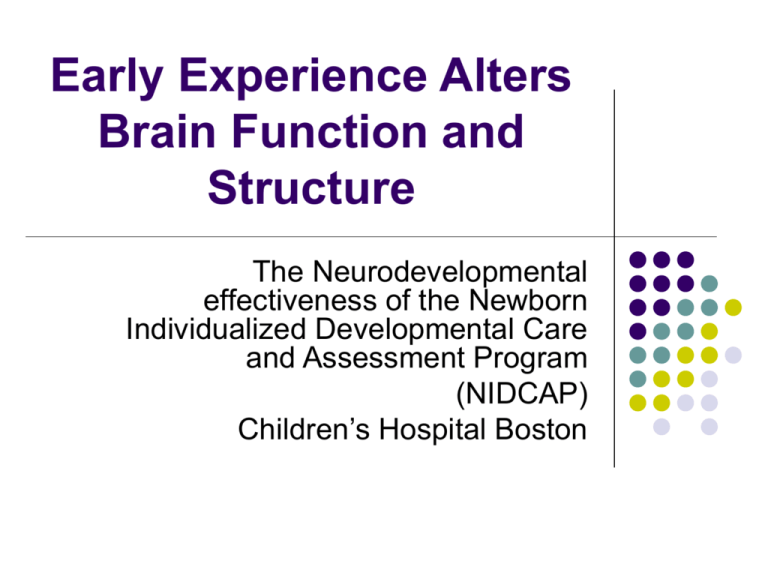
Early Experience Alters Brain Function and Structure The Neurodevelopmental effectiveness of the Newborn Individualized Developmental Care and Assessment Program (NIDCAP) Children’s Hospital Boston Reading Early experience alters brain function and structure. Als H; Duffy FH; McAnulty GB; Rivkin MJ; Vajapeyam S; Mulkern RV; Warfield SK; Huppi PS; Butler SC; Conneman N; et al. Pediatrics, 2004 Apr; 113 (4 Part 1): 846-57 ISSN: 0031-4005 PMID: 15060237 CINAHL AN: 2005082810 PDF Full Text Library Search: eResources, EBSCO Host Author: Als Rationale for Study Evidence suggests that brain structure and function are different between medically healthy preterm infants and their term counterparts. Although some differences are explained by cumulative effect of minor medical complications, the infant’s sensory experience in NICU environment may exert damaging effects on the immature brain and alter its subsequent development. Neonatal Intensive Care Unit Exposure to bright lights High sound levels Frequent noxious interventions Newborn Individualized Developmental Care and Assessment Program (NIDCAP) designed to decrease the discrepancy between immature human brain’s expectation and the actual experience in a typical NICU. Earlier studies (such as on video) Positive results in both behavioural and electrophysiological functioning of preterm infants at high risk. Similar results in low-risk 30-34 week preterm infants. Not enough evidence to warrant a multicenter clinical trial. Goal of Current Study Explore effect of NIDCAP intervention on a population of low-risk preterm infants. Neurobehavioural, electrophysiological and quantitative structural magnetic resonance imaging methods used in this study. Care Received Control Group: Standard care practice of primary care nursing and staff-dependent inconsistent parent inclusion. Uniform shielding of incubators with white hospital blankets Early use of dressing in t-shirts Side and foot rolls Liberal provision of pacifiers Inconsistent nurse-dependent encouragement of skin-to-skin (kangaroo care) contact and breastfeeding. Care Received Experimental Group: Developmental care includes: Daily observations and evaluations of infants’ behaviour with suggestions for staff and parents on how to support development specific to individual baby. Views preterm infant as fetus who finds himself too early in a technologic hospital environment instead of the evolutionarily promised mother’s womb. Behavioural individuality of each infant emphasized. Developmental Care continued Family valued as infant’s most consistent nurturer Diminishing stress on infant, Support each infant strengths and competencies Assuring restfulness, calm breathing and well modulated color, a well-functioning calm digestive tract, well-modulated face, extremity and trunk tone, comfortable rest positions and slowed tempo of all care giving procedures. Provision of well-supported relaxation periods. Developmental psychologist and neonatologist assigned. Psychologist and Neonatalogist Provided weekly observations and daily contact with caregivers, ensuring continuity and consistency of developmental care. Ongoing support for the care teams and parents in jointly planning and delivering individually supportive care. Nurses trained in Developmental Care approach assigned to infants in experimental group. Examples of Developmental Care Structure care giving procedures to the infant’s sleep/wake cycle Aroused and easily agitated infants? Tuck into a more curled up position to promote maintenance of motor tone, energy and restfulness. Gentle swaddling of infant with soft blanket or bedding, Cradling in caregiver’s hands a vulnerable infant whose breathing easily became labored. Etc. The Study Heidelise Als, Frank Duffy et al. 30 preterm infants 23 to 33 weeks gestational age (GA) Free of known developmental risk factors NIDCAP initiated within 72 hrs. ICU admission Care continued until 2 wks (corrected) Classic experimental design Control group (14) and Experimental Group (16) The Study (continued) Assessed at 2 wks. and 9 mos. corrected age 2 week assessment included: health status, growth, and neurobehaviour and electroencephalogram spectral coherence, magnetic resonance diffusion tensor imaging (MRI) 9 months assessment included: health status, growth and neurobehaviour. Neurobehaviour Assessment of Preterm Infants’ Behaviour (APIB) and Prechtl Neurologic Examination of Fullterm Newborn Infant used at 2 weeks. Measures baby’s ability to modulate behaviour in relationship to the environment. At 9 months assessment using the Bayley Scales of Infant Development, yielding a mental developmental index (MDI) and a psychomotor developmental index (PDI) and Behaviour Rating Scale (BRS) Neurophysiologic and Neurostructural Outcome Measures Sophisticated measures used of neural function responsible for complex cognitive and affective regulatory processes (EEG) Also, measures of brain development and structure (MRI and diffusion tensor imaging) Results Experimental group showed significant improvement in neurobehavioural outcome (APIB and Prechtl) Motor system modulation and self-regulation were significant variables. At 9 mos. 6 infants dropped out of study (1 control and 5 experimental). Experimental continued to show significantly better performance behaviourally. Emotional regulation, Motor quality and Total scores. Results Continued Neurophysiologically: the experimental group indicated changes in functional connectivity between brain regions. Left frontal lobe and occipital/parietal. Neurostructurally: Overall exploratory comparison of 4 individual variables revealed an overall trend in favour of the study’s hypothesis.Left frontal lobe and occipital/parietal. The MRI results provide the first evidence of significant difference in brain structure resulting from developmental intervention, which means from sensory experience of the very immature brain. Issues to Consider The Developmental Care Model views the infant as an active participant who seeks ongoing caregiver support for self-regulation during the initial stabilization phase and in the course of continuing developmental progression. Individual differences in thresholds for stimulation and irritability must be considered. Issues to Consider: The impact of developmental care at an apparently sensitive period in brain development. Even when medically at low risk, early birth nevertheless may trigger the onset of sensitive brain developmental periods. Experience before term may alter not only brain function, but also brain structure. Summary When infants receive care that is structured individually based on their own thresholds to maintain behavioural and motor system equilibrium, they seem to show improved outcome as compared with their peers who experience more standard care.
